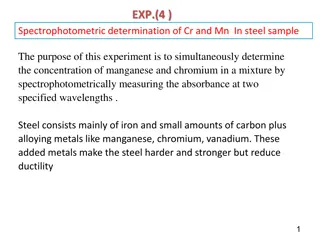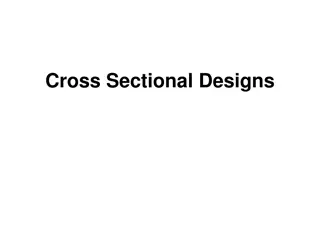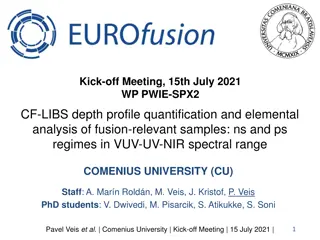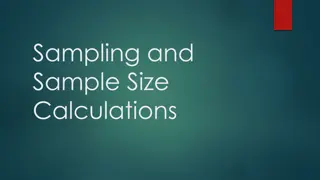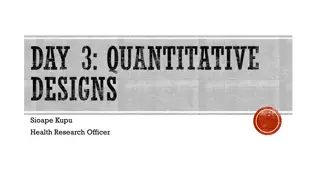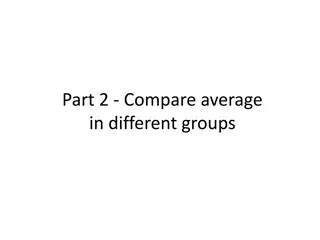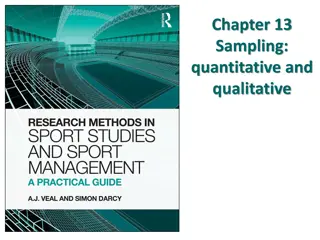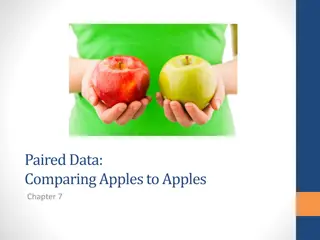Understanding Paired-Samples Designs in Research
Paired-samples designs are valuable in research when the assumption of independence is violated, leading to dependency across groups. These designs involve comparing means of two related groups with smaller variance in the dependent variable. Repeated-measures designs offer a framework for successive measurements or conditions applied sequentially to cases. Counterbalancing and wash-out periods help address order effects and carry-over effects in these designs. Simultaneous designs, where varying conditions are intermixed, eliminate concerns about order effects.
Download Presentation

Please find below an Image/Link to download the presentation.
The content on the website is provided AS IS for your information and personal use only. It may not be sold, licensed, or shared on other websites without obtaining consent from the author. Download presentation by click this link. If you encounter any issues during the download, it is possible that the publisher has removed the file from their server.
E N D
Presentation Transcript
Matched T-Test Cohen Chapter 11 For EDUC/PSY 6600 1
we are suffering from a plethora of surmise, conjecture, and hypothesis. The difficulty is to detach the framework of fact of absolute undeniable fact from the embellishments of theorists and reporters. Sherlock Holmes Silver Blaze 2
MOTIVATING EXAMPLES Dr. Filburn wishes to assess the effectiveness of a leadership workshop for 60 middle managers. The 60 managers are rated by their immediate supervisors on the Leadership Rating Form (LRF), before and after the workshop. Dr. Clarke is interested in determining if workers are more concerned with job security or pay. He gains the cooperation of 30 individuals who work in different settings and asks each employee to rate his or her concern about 1) salary level and 2) job security on a scale from 1 to 10. Dr. Gale questions whether husbands or wives with infertility problems feel equally anxious. She recruits 24 infertile couples and then administers the Infertility Anxiety Measure (IAM) to both thehusbands and the wives. 3
PAIRED-SAMPLES DESIGNS Comparing means of 2 groups Assumption of independence has been violated resulting in a dependency across groups E.g., Members of same family, class, group, litter, twinship Variance of DV smaller as groups consist of same or closely matched cases Paired-samples t-test also known as Matched-, Related-, Correlated-, Dependent-, or Non-independent samples t-test Repeated-measures t-test Experimental Naturalistic Samples naturally related, correlated, dependent Matching groups on some variable(s) E.g., sex, age, education potential confounds on IV-DV relationship or when cases cannot receive both conditions
REPEATED-MEASURES DESIGNS Successive designs: 2 measurements, conditions, or sets of stimuli are applied to cases sequentially Before-and-after (or longitudinal ) designs Pre- / post-test, time 1 / time 2 Cross-over designs Order effects? Need to counterbalance order Random subset of cases A then B Another random subset of cases B then A Counterbalancing may not eliminate carry-over effects Wash-out period Simultaneous designs: 2 varying conditions or sets of stimuli inter-mixed w/in study and all cases receive both No concern for order effects or temporality Order is generally random 5
HYPOTHESES: DIRECT DIFFERENCE METHOD Same as Independent-samples t-test H0: 1= 2 or 1 - 2 = 0 or 1 - 2 = 0 H1: 1 2 or 1> 2 or 1< 2 H0: 1 - 2 = 0 H0: D = 0 Compute difference score for each subject Xi1 Xi2 = D H0: D = 0 and H1: D 0 Now equivalent to 1-sample t-test Mean of difference scores compared w/ H0: D = 0 6
CALCULATIONS Mean of difference scoresHypothesized population difference 0 D D = = t D df = N - 1 Number of difference scores (pairs) - 1 s s D N D n __ D 2 ( ) D = SD of difference scores i = = 1 i s D 1 N 7
ASSUMPTIONS 1. Independence of pairs of observations 2. Normality of sampling distribution of difference scores in population 3. Equal ns Pair deleted when 1 member missing data 8
PAIRED-SAMPLES T-TEST AND CORRELATION Paired-samples t-test almost always more powerful than independent-samples t-test More likely to reject H0 when false Requires fewer subjects X X = 1 s n 2 t 2 1 2 2 2 s n rs s Degree of correlation (r) between scores on 2 groups related to size of difference between paired- and independent-samples t- statistics Larger correlation larger difference + 1 2 n 1 2
PAIRED-SAMPLES T-TEST AND CORRELATION Paired-samples t-test almost always more powerful than independent-samples t-test More likely to reject H0 when false Requires fewer subjects Paired-samples t-test calculated as a function of r When r = 0, equation reduces to independent-samples t- test When r > 0 denominator reduces, leading to larger t- statistic When r < 0 denominator increases, leading to smaller t- statistic Rare to have a negative correlation with paired-data Degree of correlation (r) between scores on 2 groups related to size of difference between paired- and independent-samples t- statistics Larger correlation larger difference
CONFIDENCE INTERVALS 95% CI around D __ D Rewrite: As: t = D s D N Are paired sample means significantly different? Yes: H0value not w/in CI No: H0value within CI 11
EXAMPLE Same example from independent-samples t-test lecture But suppose participants were carefully matched into pairs based on their level of depression prior to initiation of study One member of each pair was randomly assigned to drug group, other to placebo group After 6 months, level of depression was measured by a psychiatrist Need to conduct paired-samples t-test due to matching 12
R CODE: FIRST APPROACH Get the data into R df <- read.csv( drug_paired.csv ) Plot and summaries ## do some plots and summaries df %>% tidyr::pivot_longer(cols = group1:group2) %>% t.test(value ~ group, data = ., paired = TRUE) Reshape the data into long form Paired samples t-test 13
R CODE: FIRST APPROACH Paired t-test data: value by group t = -3.1009, df = 4, p-value = 0.03619 alternative hypothesis: true difference in means is not equal to 0 95 percent confidence interval: -9.4768832 -0.5231168 sample estimates: mean of the differences -5 14
R CODE: SECOND APPROACH Get the data into R df <- read.csv( drug_paired.csv ) Plot and summaries ## do some plots and summaries df %>% dplyr::mutate(group_diff = group2 group1) %>% dplyr::pull(group_diff) %>% t.test(mu = 0) Create group difference variable Single samples t-test of the group difference 15
R CODE: SECOND APPROACH One Sample t-test data: . t = 3.1009, df = 4, p-value = 0.03619 alternative hypothesis: true mean is not equal to 0 95 percent confidence interval: 0.5231168 9.4768832 sample estimates: mean of x 5 16
EFFECT SIZE *Cohen s d(same as in 1-sample t-test) D s t N = or d D Eta squared ( 2) 2 2 * t N D + = 2 or + 2 2 1 t N 2 * ( 1)* N D N s D 17
POWER ANALYSIS Post hoc With Cohen s d estimate and # pairs, compute delta to obtain power of study = N d 2 A Priori With desired power, compute delta and combine with estimated Cohen s d to obtain # pairs (N) 2 = N d
WEAKNESSES Reduction in df for critical value Lack of a control group (sometimes) If samples are not truly matched, results will be spurious 19
ALTERNATIVES Violation of normality Matched-pairs Wilcoxon Test Binomial Sign Test for Two Dependent Samples Sample Re-use methods Exact tests Randomization and permutation tests 20





